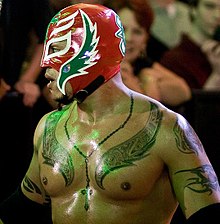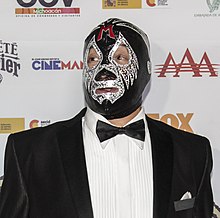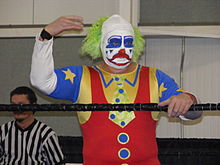Gimmick (professional wrestling)
This article needs additional citations for verification. (January 2022) |

In professional wrestling, a gimmick generally refers to a wrestler's in-ring persona, character, behaviour, attire and/or other distinguishing traits while performing which are usually artificially created in order to draw fan interest.
These in-ring personalities often involve costumes, makeup and catchphrases that they shout at their opponents or the fans.
Gimmicks can be designed to work as good guys/heroes (babyfaces) or bad guys/villains (heels) depending on the wrestler's desire to be popular or hated by the crowd. A tweener gimmick falls between the two extremes, such as wrestlers who manifests many heel and face traits such as Randy Orton's viper gimmick. A wrestler may portray more than one gimmick over their career depending on the angle or the wrestling promotion that they are working for at that time.
Promotions will use gimmicks on more than one person, albeit at different times, occasionally taking advantage of a masked character which allows for the identity of the wrestler in question to be concealed. Razor Ramon was portrayed by both Scott Hall and Rick Bognar.
Occasionally, a wrestler uses a gimmick as a tribute to another worker; such is the case of Ric Flair's Nature Boy persona which he took on as an homage to the original Nature Boy, Buddy Rogers.
When a wrestler acts outside his or her gimmick this is known as 'breaking kayfabe', a term showing pro wrestling's linkages to theatre, where the more common term "breaking the fourth wall" is used.
Gimmicks are annually rated for the Wrestling Observer Newsletter awards by the publication's owner, professional wrestling journalists, and various industry insiders, such as Dave Meltzer, promoters, agents and performers, other journalists, historians, and fans. The two awards are given to the best and worst gimmick of that year.
History[]

Beginnings (1860s to 1940s)[]
Pro wrestling's history has been tied to the use of gimmicks from its infancy. From its circus origins in the 1830s, showmen presented wrestlers under names such as “Edward, the steel eater”, “Gustave d’Avignon, the bone wrecker”, or “Bonnet, the ox of the low Alps” and challenged the public to knock them down for 500 francs.[1]
During the late 19th century-early 20th century, when wrestler Frank Gotch rose to prominence, the focus became on contests largely legitimate (see catch wrestling), which largely resulted in the abandoning previous character gimmicks.
Television era (1950s to 1970s)[]
It was not until the First Golden Age of Professional Wrestling in the United States during the 1940s–1950s, when Gorgeous George created pro wrestling's first major gimmick. His heel character focused on his looks and quickly antagonized the fans with his exaggerated effeminate behavior, drawing jealousy to the fans. Such showmanship was unheard of for the time; and consequently, arena crowds grew in size as fans turned out to ridicule George.[2]
Gorgeous George's impact and legacy on wrestling gimmicks was enormous, demonstrating how fast television changed the product from athletics to performance. Before him, wrestlers gimmicks imitated "ethnic terrors" (Nazis, Middle Eastern Muslims (Arabs, Turks, Persians, Afghans, etc.), Japs, Russians, etc.), but his success birthed a more individualistic and narcissist form of character.[3]
He was one of the first pro-wrestlers to use entrance music, "Pomp and Circumstance" which always played as he made his way to the ring.[4]
In Britain, television took British wrestling to the next level when in 1964, it went full-time as part of the World of Sport show.
The style of wrestling at the time was unique with strong emphasis on clean technical wrestling. Heels made up a minority of the roster, with most shows containing an abnormally high proportion of clean sportsmanly matches between two "blue-eyes" (as faces were known backstage in the UK). This would remain the case for several decades to come. Gimmick matches were a rarity, midget wrestling failed to catch on, while women were banned by the Greater London Council until the late 1970s.
Explosion (1980–present)[]

During the Golden Age of pro wrestling in the 1980s–1990s a rise of cartoonish, outlandish gimmicks became popular with the increase of the World Wrestling Federation's popularity.
The WWF contributed to the explosion of gimmicks by becoming the most colorful and well-known wrestling brand because of its child-oriented characters, soap opera dramatics and cartoon-like personas. Most notable was the muscular Hulk Hogan, who marked the 1980s with his "all-American" gimmick and made his main events into excellent ratings draws. His dominant role in the industry at that time led to this era to be also known as "Hulkamania". Around this time, wrestling became a form of entertainment rather than an official sport.
Other wrestlers from this era with similarly outlandish characterization include Ric Flair, Sting and The Undertaker.
In recent years, the emphasis has been on more realistic gimmicks that portray the wrestler as an actual person, sometimes using their real names, albeit with exaggerated personality traits. Wrestlers like Randy Orton, Batista, and John Cena are prime examples of this.[5]
Common gimmicks[]
Related to origin[]
Exaggerating the characteristics of a wrestler's (on occasion fabricated) origin is one of the most commonly exploited gimmicks, in which overarching characteristics of a character play up to clichés and stereotypes.

The undeniable influence of the Puroresu style in the world of professional wrestling has resulted in many wrestlers using fabricated Japanese origins or being billed from a Japanese city, without actually being natives of the country. Prime examples of this include Yokozuna, Awesome Kong, Hawaiians Professor Tanaka and Mr. Fuji, and British wrestler Kendo Nagasaki. Several Japanese wrestlers who wrestle outside of their home country are known to play up or exaggerate aspects of their cultural heritage as part of their gimmicks for an overseas audience.
Masked[]

Masked wrestlers made their appearance in Europe ( in France, 1865) and the United States (Mort Henderson as "Masked Marvel" in 1915) considerably earlier than in Mexico, but it was the latter that popularised the use of masks. This, in some cases to signify a high-flyer style, influenced by Lucha Libre.
A specific masked gimmick may be used by more than one wrestler at a wrestling company's request since their identity can be permanently concealed. This is the case of Mexican Sin Cara and Japanese Tiger Mask. Masks also allow a wrestler to perform as more than one character for a variety of wrestling promotions.
Other wrestlers that have used masks in their performances include: The Masked Superstar, Mexican-Americans Rey Misterio, and most recently, Kalisto, Lince Dorado, Gran Metalik, or Japanese legend Jyushin Thunder Liger.
Sports[]
A high number of wrestlers who start their careers in another sport incorporate their athletic abilities as part of their act. That is the case for Olympic medallist Kurt Angle, who previously competed in freestyle wrestling and alludes to it in his attire and wrestling style. Brock Lesnar is also an ex-amateur wrestler, NFL player and UFC champion. Welsh wrestler Mason Ryan is also a former Gladiator and football player. English wrestler Wade Barrett was also a former bare-knuckle fighter as well as Elijah Burke who is also a former amateur boxer. Former MMA fighters Ronda Rousey and Shayna Baszler also uses their MMA background as part of their characters as well as former American Ninja Warrior competitor Kacy Catanzaro, former kung-fu fighter Xia Li, and Matt Riddle, who always wrestles barefooted during matches, presuming that he had an MMA background career in the past before debuting in WWE along with Mojo Rawley's "hyperactive" wrestling style due to being a former NFL player before debuting WWE as well as the stable The Four Horsemen.
Comic-based characters[]
The theatrical nature of professional wrestling easily blends with comic hero and villain characters, made popular in the 1990s by Sting, whose character was inspired by the 1994 movie The Crow, based on the comic book of the same name. Other wrestlers with superhero and supervillain gimmicks include The Hurricane or Nikki ASH.
Supernatural-based characters[]

Similarly to superheroes and supervillains, supernatural characters add to entertainment value. Most famously in this category is The Undertaker, considered one of the most respected wrestlers in the business, whose gimmick is a horror-themed character of an undead, macabre and paranormal dark presence prone to scare tactics. He was managed by the ghostly character that was Paul Bearer and tagged with his half-brother Kane in The Brothers of Destruction stable.
Juggernaut[]
Since its beginnings in the circus circuit, the professional wrestler's stereotype has been that of large, powerful and strong. Various wrestlers have banked on the larger size which has influenced their in-ring style and persona.
Notable examples of these kind include Swede Tor Johnson (181 kg), Gorilla Monsoon (182 kg), Giant González (8 ft 0 in), André the Giant (7 ft 4 in), The Great Khali (7 ft 3 in), Big Show (7 ft 2 in), Awesome Kong and Nia Jax (123 kg).
Midget[]
Similarly to juggernauts, since its beginnings in the circus circuit, the professional wrestler's stereotype has been that of small, but powerful and strong like those of dwarves of Norse mythology. Various wrestlers have banked on the small size which has influenced their in-ring style and persona.
Notable examples of these kind include the leprechaun Hornswoggle, El Torito and other various dwarfed versions of other various wrestlers.
Educational[]
Whilst "education" is rare in wrestling, it has been recently been a popular gimmick due to the fact that the wrestler is a former real-life student or scholar of a school, a college, a university, or a TAFE, who also worked as a cheerleader, a coach, a dean, a librarian, a teacher, or even a principal. Wrestlers who used this gimmick include NXT wrestlers, e.g. Alex Riley etc., Bobby "The Brain" Heenan, Sgt. Slaughter, Dean Douglas, Jonathan Coachman, Michelle McCool's "sexy teacher" character, The Miz's and Jack Swagger's "student" amateur background characters, Damien Sandow's "Intellectual Savior of the Unwashed Masses" character, and "The Librarian" Peter Avalon and his manager Leva Bates, and tag-teams The Steiner Brothers, The Spirit Squad, and most recently, Team Rhodes Scholars, and American Alpha.
Religious[]
Religion is often a rare gimmick since that fans are not quite interested in it either. Wrestlers who used this gimmick include Friar Ferguson, and most recently, "Bolieve" Bo Dallas, and "The Monday Night Messiah" Seth Rollins.
Hardcore technician[]
Whilst being way beyond over the limit from some sheer violence is scary in some matches, hardcore technician gimmicks are also another popular choice for gimmicks, due to the fans being over with getting used to watching sheer violence as they don't shy away from it either. These include Abdullah the Butcher, and Bruiser Brody, which came popular into other professional wrestling companies like ECW wrestlers, e.g. Terry Funk, Hardcore Holly, New Jack, and Mick Foley/Mankind/Cactus Jack, etc., CZW wrestlers, e.g. John Zandig, Necro Butcher, Wifebeater, Nick Mondo, and Nick Gage, etc., AEW wrestlers, e.g. The Blade, and The Butcher, etc., Japanese Wrestlers Atsushi Onita, Toshiaki Kawada, and Jun Kasai, and tag-teams The Motor City Machine Guns, and most recently, The Mechanics, and Heavy Machinery.
Music-based characters[]
Music influences are another popular choice for gimmicks. In the 80's, The Honky Tonk Man worked with a Elvisesque character. John Cena worked during the first years of his career with a rapper gimmick.
Comedy[]

Whilst humor has long been present in professional wrestling matches and many wrestlers incorporate elements of comedy in their act, full-on comedic gimmicks are not commonly seen. These are sometimes reserved for wrestlers who not always have the stereotypical physique required in the industry and instead exploit their entertainment abilities.
Initiated by English wrestler Les Kellett, wrestlers who fall under this category are Doink The Clown which was majorly portrayed by Matt Osborne until his death in 2013, which inspired others like Scottish comedian and actor Grado, Ring of Honor's Colt Cabana, Santino Marella, James Ellsworth, and Eugene's "mentally disabled boy" character, Japanese Wrestlers Stalker Ichikawa, Gran Naniwa, Kuishinbo Kamen and Toru Yano, Charlie Haas during his impersonations run, and WWE's 1990s turkey character Gobbledy Gooker, and rooster character Red Rooster, WCW's Brian Pillman, and Al Snow along with his mannequin prop called "Head" which he used as a sidekick companion during segments while addressing the fans. And recently, The New Day pursued a joyous gimmick, giving them a character heavily associated with the fans. Damien Sandow also falls under this category due to his 'stunt double' gimmick in late 2014 where he copied whatever his on-screen mentor The Miz did, due to the latter using a gimmick of an arrogant movie star. R-Truth also influenced his character with some of his comedic activities, such as breaking out a joke, dancing and finding out his opponent to win the 24/7 Championship in a strange and funny way.
Charity[]
Characters who do charity are depicted as a heroic gimmick due to real-life charity. Wrestlers who used this gimmick include Sweet Daddy Siki, Brother Love, "Make a Difference" Fatu, Dude Love, and most recently, "The Doctor of Hug-o-nomics" Bayley, and tag-team Men on a Mission.
Self-absorbed[]
Usually a villainous gimmick, initiated by Gorgeous George, due to the jealousy of the good looks the fans want to have for themselves.
Hollywood movie star[]
Hollywood movie stars are occasionally villainous due to fame outside of wrestling as a real-life Hollywood actor/actress. These include "Hollywood" Hulk Hogan, The Rock, and most recently, Batista, John Cena, The Miz, and David Otunga's A-list character, and tag-teams The Hollywood Blondes, and MNM, and most recently, The Bollywood Boyz, despite being of Indian descent and being billed from the famous Indian filming district of Bollywood, Mumbai (Bombay), instead which they were named after (although the name "Bollywood" was borrowed from the word "Hollywood" but with a "B" instead of a "H" to describe a famous filming district in Mumbai (Bombay), in India, which it was named after).
Authority-based characters figure[]

Some wrestlers use a character based on an authority over other people. This includes being owners of the promotion, like Mr. McMahon (since he is the real owner of WWE) or around royal characters, like Jerry The King Lawler.
Money-based characters[]
The evil billionaire/millionaire tyrant character works well as a villain — due to the jealousy of the fans who want the things "money can't buy" for themselves which they can't afford — in contrast to professional wrestling's working-class fan-base. It is because of this audience that Dusty Rhodes' Common Man or "American Dream" was highly successful with the crowds.
The original gimmick of this type was created by "Million Dollar Man" Ted DiBiase. JBL used his real-life work as Wall Street investor as base for his JBL character.
Hated crime gang/Terrorist thugs/Bad guy bandits/Mafia mobsters[]
Hated crime gang/terrorist thugs/bad guy bandits/mafia mobsters work perfectly well as villainous gimmick due to real-life crime gangs, terrorist thugs, bandits, and mobsters but has become a more popular gimmick (partially due to being over with fans who seem to be more malicious, malevolent, violent, aggressive, erratic, or hostile, and seem show no respect, remorse or sympathy — especially when they show some profanity — to the heels, even if they are trying to be friendly, polite, or nice to them, especially when they are telling them they are or telling them to by placating them).
Other usage[]
- Within professional wrestling in insider usage the word 'gimmick' has come to refer to an array of other related terms, including any weapon or foreign object used during a match or the scripted quality of a match.[6]
- In backstage lingo, gimmick is also a stand-in for basically any physical noun or set of moves in a match.
- Gimmicked is used to describe an object that is altered or rigged for use in a match. For example, a gimmicked table or chair which would be precut or made to fall apart more easily.[7]
- An event that is referred to as a gimmick event is one that is based around a match type, such as the pay-per-view events WWE Hell in a Cell and WWE TLC: Tables, Ladders, & Chairs.[8]
- The term is also a euphemism for hormone-enhancing drugs, namely steroids and growth hormone, which have historically been linked to the sport.
- It has also been used by people in the profession to describe casual marijuana use, as wrestlers will refer to 'smoking the gimmick'.
See also[]
References[]
- ^ "History of Wrestling - United World Wrestling". unitedworldwrestling.org. Archived from the original on 2016-03-27. Retrieved 2016-02-08.
- ^ Thesz, Lou. Hooker. p. 100.
- ^ Assael, Shaun. Sex, Lies, and Headlocks. p. 11.
- ^ Foley, Mick (2010). The Fabulous, Freaky, Unusual History of Pro Wrestling (Unusual Histories). Velocity Business Publishing. pp. 48. ISBN 978-1429647892.
- ^ ""CHARACTER" ACTORS - Jim Cornette.com". jimcornette.com.
- ^ Shoemaker, David (13 August 2014). "Grantland Dictionary: Pro Wrestling Edition".
- ^ "Wrestling Dictionary of Terms".
- ^ Ferrer, Mike (August 2, 2012). "What is it that differentiates classic PPVs from "Gimmick PPVs"?". Súper Luchas (in Spanish). Retrieved January 21, 2022.
- Professional wrestling gimmicks
- Professional wrestling slang
